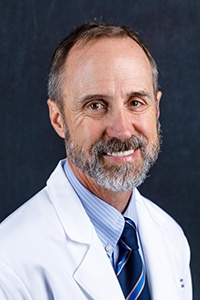
Associate Dean of Academic Affairs and Curriculum
Education
- PhD, University of Missouri School of Medicine
- MS, University of Arizona
- BA, Calvin College
Courses Taught
- Integument and Musculoskeletal Systems – IMSK
- Cardiovascular Respiratory Hematologic System – CVRH
- Cardio/pulmonology – CP
- Orthopedics/Rheumatology/Dermatology – ORD
Professional Memberships
- American Physiological Society
- American College of Sports Medicine
- American Scientific Affiliation
Biography
At Liberty University College of Osteopathic Medicine, Dr. Jasperse serves as the Assistant Dean for Academic Affairs & Curriculum Professor of Integrative Physiology. He teaches primarily in the areas of cardiovascular, respiratory, muscle, and exercise physiology. Prior to arriving at LUCOM, he was a faculty member at Pepperdine University in California for 18 years.
His research focuses on the cellular signaling mechanisms involved in the regulation of skeletal muscle blood flow at rest, at the onset of exercise, and during sustained exercise. He is also interested in how this signaling is altered by exercise training, detraining, and various diseases.
Publications
- Clifford, P.S., B.S. Ferguson, J.L. Jasperse, and M.A. Hill. Arteriolar vasodilation involves actin depolymerization. Am. J. Physiology (Heart Circ. Physiol.) 315(2):H423-H428, 2018.
- Olver, T.D., M.W. McDonald, D. Klakotskaia, R.A. Richardson, J.L. Jasperse, C.W.J. Melling, T.R. Schachtman, H.T. Yang, C.A. Emter, and M.H. Laughlin. Physical activity reverses obesity-related cerebrovascular dysfunction by normalizing the contributions of ET-1 and NO to insulin-mediated vasodilation. J. Appl. Physiol. 122(4):1040-1050, 2017.
- Jasperse, J.L., J.K. Shoemaker, E.J. Gray, and P.S. Clifford. Positional differences in reactive hyperemia provide insight into initial phase of exercise hyperemia. J. Applied Physiology 119(5):569-575, 2015.
- Clifford, P.S. and J.L. Jasperse. Feedforward vasodilatation at the onset of exercise. Journal of Physiology 583(3):811, 2007.
- Clifford, P.S., H.A. Kluess, J.J. Hamann, J.B. Buckwalter, and J.L. Jasperse. Mechanical compression elicits vasodilatation in skeletal muscle vasculature. Journal of Physiology 572(2):561-567, 2006. (This article was highlighted in the “Highlights from the Literature” section of Physiology 21(3):159, 2006).
- Jasperse, J.L. and M.H. Laughlin. Exercise training and endothelial function in animals. Med. Sci. Sports Exer. 38(3):445-454, 2006.
- Jasperse, J.L. and M.H. Laughlin. Exercise and Skeletal Muscle Circulation. In Microvascular Research: Biology and Pathology, Chapter 85, P. 553-564. Ed. By D. Shepro, Elsevier Academic Press, New York, 2006.
- McAllister, R.M., J.L. Jasperse, and M.H. Laughlin. Nonuniform effects of endurance exercise training on vasodilation in rat skeletal muscle. J. Appl. Physiol. 98:753-761, 2005.
- McAllister, R.M., I. Albarracin, J.L. Jasperse, and E.M. Price. Thyroid status and endothelium-dependent vasodilation in skeletal muscle. Am. J. Physiol. 288 (Regulatory Integrative Comp. Physiol.):R284-R291, 2005.
- Jasperse, J.L., C.R. Woodman, E.M. Price, E.M. Hasser, and M.H. Laughlin. Hindlimb unweighting decreases ecNOS gene expression and endothelium-dependent dilation in rat soleus feed arteries. J. Appl. Physiol. 87(4):1476-1482, 1999.
Research Interests
- Regulation of blood flow to skeletal muscle